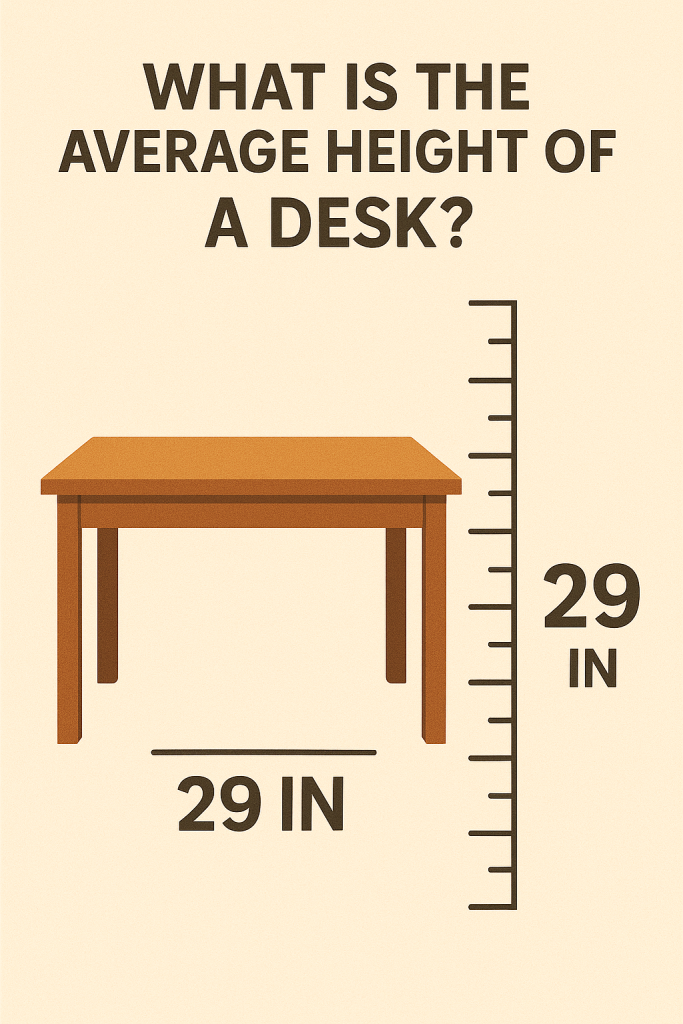Average height of a desk shapes workspace comfort and health. How do standards differ? Why does height matter? What does this mean for offices? This exploration dives into the data, revealing a story of ergonomics and productivity. Standard US desks sit at 29 inches, ideal for those 5 feet 8 inches to 5 feet 10 inches tall.

Yet, global variations exist—Singapore desks trend lower at 73 cm. For professionals, desk height informs furniture choices, office layouts, and employee health. A well-set desk boosts focus and cuts back pain!
Global Desk Height Standards
The average height of a desk varies by region. In the US, sitting desks range from 28 to 30 inches (73–76 cm), suiting adults 5 feet 8 inches to 5 feet 10 inches. Standing desks stretch higher, 38 to 46 inches, for flexibility. In England, desks align at 73–76 cm. Singapore and Japan favor 73 cm, accommodating shorter average heights. Australia mirrors the US, with 73–76 cm for sitting desks.
These standards assume a 90-degree elbow angle while typing. For a 6-foot person, 29 inches fits sitting desks, but taller users need 30–31 inches. Shorter users, under 5 feet 4 inches, may prefer 26–27 inches. Adjustable desks solve this, ranging 22–33 inches. Professionals can use desk height calculators to find the sweet spot—divide height in inches by 2, subtract 8.5 for minimum, 6 for maximum.
Historical Trends in Desk Heights
Desk heights have shifted over time. Pre-1900, desks stood ~30 inches, built for writing by hand. By the 1980s, computers drove ergonomic changes, lowering desks to 28–29 inches for typing comfort. The 2000s brought adjustable desks, now standard in 2025, with sitting heights at 29 inches and standing at 38–46 inches. In the US, 29 inches became the norm for 5’8”–5’10” users.
Globally, trends vary. Japan’s 73 cm desks reflect shorter statures. In the Philippines, no specific data exists, but desks likely align with global 73–76 cm, adjusted for men (5’4”) and women (5’1”). Children’s desks, at 55 cm for first-graders, show early ergonomic focus. Professionals can study historical shifts to anticipate future adjustable desk trends.
Influencing Factors
User height drives desk standards. A 6-foot person needs a 27–30 inch desk for sitting, while a 5-foot-2 person suits 24–26 inches. Chairs matter—adjustable seats (16–20 inches) align with 29-inch desks. Ergonomics demand a 90–110° elbow angle, with feet flat and forearms parallel to the floor. Monitor height, 2–3 inches below eye level, complements desk setup.
Desk type shifts heights. Sitting desks average 28–30 inches, standing desks 38–46 inches. Children’s desks start at 55 cm, adjustable for growth. Materials—wood, metal—don’t change height but affect durability. Regional standards reflect average heights—Singapore’s 73 cm suits 5’6” users, while US desks target taller frames. Professionals can recommend adjustable desks or footrests for mismatched heights.
Regional and Socioeconomic Variations
Desk heights differ by region. US desks (28–30 inches) suit taller populations (men 5’9”, women 5’4”). Australia follows, with 73–76 cm. Singapore and Japan use 73 cm, fitting shorter frames (men ~5’6”). In the Philippines, desks likely hit 73–76 cm, but rural offices may use lower, non-standard desks due to cost. Urban Manila offices align with global norms.
Socioeconomics play a role. Wealthier firms invest in adjustable desks (22–33 inches), while budget offices stick to 29 inches, less ideal for diverse heights. These gaps guide action—urban retailers stock adjustable desks, rural ones fixed-height models. Professionals can push for ergonomic upgrades to boost workplace health.
Business and Societal Implications
The average height of a desk impacts industries. Furniture retailers stock 28–30 inch desks for standard offices, but adjustable models (22–33 inches) gain traction. Office managers use height calculators to design ergonomic spaces, reducing back pain. Ergonomists advocate for 90° elbow angles, cutting workplace injuries. In schools, 55 cm desks for kids promote posture.
Desk height shapes culture. Ergonomic offices signal care for employees, boosting morale! Retailers can market adjustable desks for home offices, while schools adopt scalable furniture. Professionals can design health campaigns or ergonomic products to align with the average height of a desk.
Average Height of a Desk: Actionable Takeaways
Average height of a desk—28–30 inches in the US—guides ergonomic success. Professionals can act: retailers can stock adjustable desks, managers can use height calculators, and ergonomists can push for 90° elbow setups. Desk height drives comfort, health, and productivity. Keep tweaking—workspaces are evolving!
Average Height for 2 Year Old: Growth Insights
Average Height of a Desk: Ergonomic Insights
Average Height of a 4 Year-Old in Feet: Growth Insights
